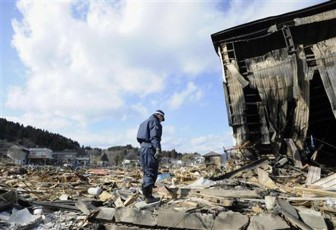TOKYO, (Reuters) – Exhausted engineers attached a power cable to the outside of Japan’s tsunami-crippled nuclear plant today in a race to prevent deadly radiation from an accident now rated at least as bad as America’s Three Mile Island incident in 1979.

Further cabling inside was under way before an attempt to restart water pumps needed to cool overheated nuclear fuel rods at the six-reactor Fukushima plant in northeastern Japan, 240 km (150 miles) north of Tokyo. Japan’s unprecedented multiple crisis of earthquake, tsunami and radiation leak has unsettled world financial markets, prompted international reassessment of nuclear safety and given the Asian nation its sternest test since World War Two.
It has also stirred unhappy memories of Japan’s past nuclear nightmare — the U.S. atomic bombs dropped on Hiroshima and Nagasaki in 1945.
Working inside a 20 km (12 miles) evacuation zone at Fukushima, nearly 300 engineers were focused on trying to find a solution by restoring power to pumps in four of the reactors. “TEPCO has connected the external transmission line with the receiving point of the plant and confirmed that electricity can be supplied,” the plant’s operator Tokyo Electric Power Co said in a statement. Another 1,480 metres (5,000 feet) of cable are being laid inside the complex before engineers try to crank up the coolers at reactor No.2, followed by numbers 1, 3 and 4 this weekend, company officials said.
If that works it will be a turning point.
“If they are successful in getting the cooling infrastructure up and running, that will be a significant step forward in establishing stability,” said Eric Moore, a nuclear power expert at U.S.-based FocalPoint Consulting Group.
If not, there is an option of last resort under consideration to bury the sprawling 40-year-old plant in sand and concrete to prevent a catastrophic radiation release.
That method was used to seal huge leakages from the 1986 Chernobyl disaster.
Underlining authorities’ desperation, fire trucks sprayed water overnight in a crude tactic to cool reactor No.3, considered the most critical because of its use of mixed oxides, or mox, containing both uranium and highly toxic plutonium.
Japan has raised the severity rating of the nuclear crisis to level 5 from 4 on the seven-level INES international scale, putting it on a par with the Three Mile Island accident in 1979, although some experts say it is more serious.
Chernobyl, in Ukraine, was a 7 on that scale.
THOUSANDS DEAD,
MISSING AND SUFFERING
The operation to avert large-scale radiation has overshadowed the humanitarian aftermath of the 9.0-magnitude quake and 10-metre (33-foot) tsunami that struck on March 11.
Nearly 7,000 people have been confirmed killed in the double natural disaster, which turned whole towns into waterlogged and debris-shrouded wastelands.
Another 10,700 people are missing with many feared dead.
Some 390,000 people, including many among Japan’s ageing population, are homeless and battling near-freezing temperatures in shelters in northeastern coastal areas.
Food, water, medicine and heating fuel are in short supply.
“Everything is gone, including money,” said Tsukasa Sato, a 74-year-old barber with a heart condition, as he warmed his hands in front of a stove at a shelter for the homeless.
Health officials and the U.N. atomic watchdog have said radiation levels in the capital Tokyo were not harmful. But the city has seen an exodus of tourists, expatriates and many Japanese, who fear a blast of radioactive material.
“I’m leaving because my parents are terrified. I personally think this will turn out to be the biggest paper tiger the world has ever seen,” said Luke Ridley, 23, from London as he sat at Narita international airport using his laptop.
“I’ll probably come back in about a month.”
Though there has been alarm around the world, experts have been warning there is little risk of radiation at dangerous levels spreading to other nations.
The U.S. government said “minuscule” amounts of radiation were detected in California consistent with a release from Japan’s damaged facility, but there were no levels of concern.
Amid their distress, Japanese were proud of the 279 nuclear plant workers toiling in the wreckage, wearing masks, goggles and protective suits sealed by duct tape.





